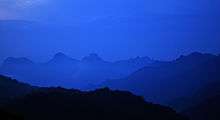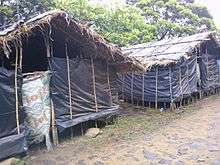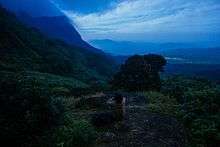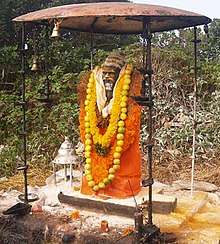Agastya Mala
Agasthyarkoodam is a 1,868-metre (6,129 ft)-tall peak of the Pothigai mountain range of Tamil Nadu in the Western Ghats of South India. The peak lies on the border of Tamilnadu and Kerala.[1] This peak is a part of the Agasthyamala Biosphere Reserve which lies on the border between the Indian states of Kerala (in Pathanamthitta, Kollam and Thiruvananthapuram districts) and Tamil Nadu (in Kanyakumari district, Tirunelveli district). The perennial Thamirabarani River originates from the eastern side of the range and flows into the Tirunelveli district of Tamil Nadu.
| Agastya rishi | |
|---|---|
A view of Agasthyarkoodam from the base | |
| Highest point | |
| Elevation | 1,993 m (6,539 ft) |
| Prominence | 1,497 m (4,911 ft) |
| Coordinates | 8°37′N 77°15′E |
| Naming | |
| English translation | Hill of Agasthya |
| Language of name | Tamil |
| Geography | |
 Agastya rishi Border of kanyakumari district, thirunelveli District, of tamilnadu and pathanamthitta district, thiruvananthapuram District, of Kerala,
India | |
| Parent range | Western Ghats |
Agasthyarkoodam is a pilgrimage centre for devotees of the Hindu sage Agastya, who is considered to be one of the seven rishis (Saptarishi) of Hindu Puranas. In Tamil traditions, Agastya is considered as the father of the Tamil language and the compiler of the first Tamil grammar called Agattiyam or Akattiyam.[2] and also the Malayalam language is considered to be born from Agasthya. There is a small stone statue of Agathiyar at the top of the peak and the devotees can offer pujas themselves.
Agasthyamala Biosphere Reserve is among 20 new sites added by UNESCO to its World Network of Biosphere Reserves in March 2016. The International Co-ordinating Council added the new sites during a two-day meeting on 19 March 2016 in Lima, bringing the total number of biosphere reserves to 669 sites in 120 countries, including 16 transboundary sites.It includes close to 300 rare bird species and more than 200 medicinal plants found only here.[3]
Geography
Agasthyarkoodam is 32 km from Neyyar Dam and 23 km from Bonacaud, near Ponmudi. The major city and airport nearest to Agasthyarkoodam is Thiruvananthapuram (Trivandrum) and its Trivandrum International Airport, around 61 km away. The nearest railway stations are Thiruvanathapuram, Kerala and Ambasamudram, Tirunelveli District, Tamil Nadu. The trekking path, nearly 35 km, is from Bonacaud.
Kalakkad Mundanthurai Tiger Reserve is part of the Agasthyarkoodam range. Part of the peak can be seen from the Upper Kodayar region.

Other major rivers which originate from the mountain are the Karamana River, which flows through the Thiruvananthapuram district and is the major source of drinking water to the city, and the Neyyar River (also in the Thiruvananthapuram district).
Trekking routes

The peak of Agasthyarkoodam[4] can be reached only by trekking up to it. Trekking[5] is allowed based on strict guidelines and is open to pilgrims during January to mid-March. Trekking passes are issued by Kerala Forest Department from the district office at Trivandrum.[6][7] The trekking route starts from Bonacaud. The route "Neyyar-Agasthyakoodam" is not open to the public.
Vehicles reach only till Bonacaud which is around 50 km from Thiruvananthapuram. The trek to the peak is 20 km long from Bonacaud and requires two days. The first part of the trek can be started from the base station Bonacaud in the early morning and is 14 km through the forest to the camp. Elephants and wild bulls are in abundance in this part especially in the evenings. The final part i.e. the 6 km long trek can be done from the camp to the top of Agathyakoodam mountain on the second day.


Vegetation
The lower elevations of this peak are known for their abundance of rare herbs and medicinal plants. Around 2,000 medicinal plants used in Ayurvedic treatments are found here. Europeans, particularly those from England, were the first to establish tea gardens around the base stations of the mountain at Brimore, Bonacaud, and Ponmudi.
The Agasthyamala Biosphere Reserve harbours rare flora and fauna. Tourists are permitted to the area only with permission from the forest department of Kerala. Annual trekking passes to the peak are issued from the forest department during January–February only.
Important places

Manjolai Hills
Between elevations ranging from 1000 to 1500 metres, the Manjolai area is set deep within the Western Ghats within the Kalakkad Mundanthurai Tiger Reserve in the Tirunelveli District. Located on top of the Manimuthar Dam and the Manimuthar Water Falls, the Manjolai area has tea plantations, small settlements around the tea plantations, Upper Kodaiyar Dam, and a windy view point called Kuthiravetti.
The tea plantations and the whole of Manjolai Estates are operated by the Bombay Burmah Trading Corporation Ltd on forest lands leased by the singampatti zamin. There are three tea estates in the Manjolai area — Manjolai Estate, Manimutharu Estate, and Oothu Estate. The estates are on elevations ranging between 2,300 and 4,200 feet (701 and 1,280 m). The estates, road, and the settlements in the Manjolai area are managed by the Bombay Burmah Trading Corporation Ltd.
Online reservation for Agasthyarkoodam visit
Online Reservation can be done using the site.[8]
Former status prohibiting women
Prior to November 2018, women were forbidden to climb Agasthyarkoodam. After a court ruling which removed the prohibition, a woman, Dhanya Sanal, reached the peak in 2019, becoming the first woman known to make the climb. Since the change in the law, more than 100 other women have registered for a license to make the climb.[9]
On 17 January 2020, 71 years old Visalakshi Amma (from Coimbatore) along with her son (Vandhan) and daughter-in-law (Lakshmy Kolary) embarked on the Trek. On 18th She successfully scaled up to the PongalaPara and went beyond close to the first ropeway. But due to unfavorable climatic conditions (rain and dense fog) and health concerns of her accomplices forced her to return to the camp without scaling the peak (2 km short). She garnered huge respect and adulations from all those who had trekked and present during the period at the camp. Many said they drew inspiration from her for her grit and determination and fondly called her "Trekker Ammumma".
See also
References
- Google Maps
- [Richard S Weiss 2009, p. 50–51, 81–82] and [Klaus Klostermaier (2003), A Concise Encyclopedia of Hinduism, Oxford: Oneworld Publications, ISBN 1-85168-175-2, page 17]
- "UNESCO added Agasthya Mala to its World Network of Biosphere Reserves in 2016". The Economic Times. PTI. 21 March 2016. Retrieved 12 July 2016.
- "Agasthyarkoodam-Agasthyamala- heaven for trekkers-hill station-Bird watchers paradise-reserve forest in Kerala - XploreSouth". xploresouth.in. Archived from the original on 27 September 2015. Retrieved 26 September 2015.
- "Agasthyakoodam Trek". keralatripguide.com.
- "Passes for visiting Agasthyakoodam from January 9". EnteCity News.
- "No Plastic This Time To Agasthyarkoodam; Trek Starts 15 Jan - Trivandrum News - Yentha.com". yentha.com.
- "ServicePlus - T1". serviceonline.gov.in. Archived from the original on 13 January 2018. Retrieved 12 January 2018.
- Regan, Helen (18 January 2019). "Indian woman is first to climb Kerala mountain reserved for men - CNN". Edition.cnn.com. Retrieved 31 January 2019.
External links
| Wikimedia Commons has media related to Agastya Mala. |